Alaska Economic Trends
Alaska Economic Trends is a monthly magazine that covers a range of economic topics.
Sign up for a free electronic subscription. 
Sign up for a paid print subscription.
Alaska Economic Trends are searchable from 1961 to the present using the Trends search page. The search can include any combination of the following: Key Words, Date Range, Author, Category
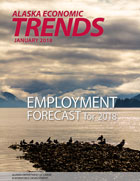
Alaska is expected to lose jobs again in 2018, although the losses appear to be tapering. Total employment is forecasted to decline by 0.5 percent in 2018 (-1,800 jobs) after falling 1.1 percent in 2017 and 1.9 percent in 2016. Losses were deepest in 2016 when the state's economy shed 6,300 jobs, primarily in oil and gas and in state government. Then in 2017, Alaska lost an estimated 3,600 jobs. If it hadn't been for strong health care growth, the overall job loss would have been deeper.
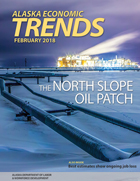
Prudhoe Bay, home to the nation's largest oil field, is what single-handedly transformed Alaska into an oil-producing powerhouse and became the source of the state's greatest wealth. According to historian Terrance Cole, The balance sheet of Alaskan history is simple: One Prudhoe Bay is worth more in real dollars than everything that has been dug out, cut down, caught, or killed in Alaska since the beginning of time. And yet, it's a place few Alaskans ever visit.
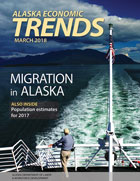
Alaska has the highest population turnover of any state, with large numbers of people moving both in and out each year regardless of economic conditions. Although the percentage of residents born in Alaska has risen over time - 41 percent today versus 32 percent in 1980 - Alaska's population remains highly migratory compared to the rest of the U.S.
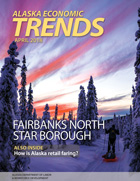
The Fairbanks North Star Borough, at the center of Alaska's interior in the Tanana Valley, is North America's northernmost settlement of its size. While the borough has just two incorporated cities - Fairbanks and North Pole - and a handful of smaller communities, its land mass is about the size of New Jersey.

Alaska's marijuana industry is still in its infancy. Voters legalized recreational use in 2014, but marijuana wasn't available commercially until 2016. Most licenses are less than a year old, and many licensed marijuana businesses don't yet show up in wage and salary records because they don't have employees. However, initial data show a steady increase in tax revenue, wages and employment, and the number of licenses in Alaska.

Debt often has a bad connotation, but it's a financial tool that's neither positive nor negative on its face. Taking on debt can represent anything from a sound long-term investment to current consumption at the expense of future financial options.
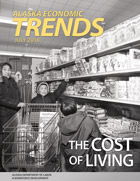
Inflation hovered near a record low for a third straight year in 2017, with the Anchorage Consumer Price Index increasing just 0.5 percent. This is the first time inflation in Alaska hasn't topped half a percentage point for three years in a row.
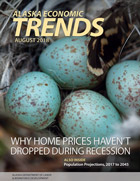
Since Alaska entered a recession in late 2015, prices for single-family homes have remained relatively stable overall and have even continued rising in more populated areas.
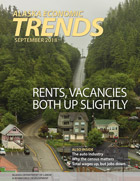
For more than 25 years, we have surveyed landlords in cooperation with the Alaska Housing Finance Corporation to assess rental costs and vacancy rates in selected areas.
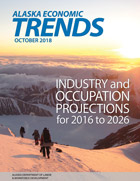
Every two years we project jobs by industry and occupation for a 10-year period, and October provides our newest set for 2016-2026. We project overall job growth at just over 5 percent, with the highest growth in health care.
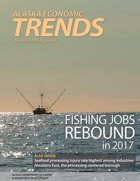
After a steep drop in 2016, seafood harvesting employment rebounded in 2017, growing 8.3 percent and hitting a record of 8,509 average monthly jobs.

Health care practitioners and technicians make an average of $98,020 a year in Alaska, making Alaska the highest-paying state for these jobs overall. The national average is $80,760.
